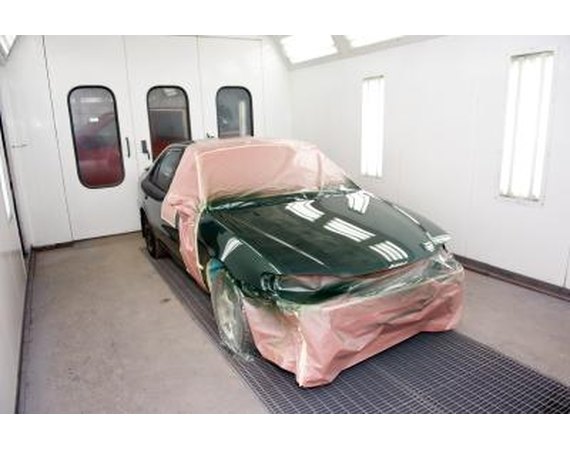
The process of painting an automobile must be preceded by blocking or masking. Blocking involves covering or removing unpainted surfaces such as windows, door handles and trim so that they do not become coated as paint is applied to the rest of the car. If done correctly, blocking can result in a neat and tidy paint job. If not, poor blocking can result in more cleanup work than the painting itself. To perform your own blocking, you will need a careful eye and some basic supplies.
Instructions
- 1
Clean the car. Wipe away as much dirt and grease as possible, then wash the painted surface of your car in preparation for painting. You can use dish detergent, a sponge and water from a garden hose. Rinse the soap off thoroughly, and dry the car with a chamois cloth.
2Use masking paper and auto masking tape to block off all the windows around your car. Roll your masking paper across each window and tuck it beneath the trim border. Use the edge of credit card to slide the masking paper into position under the trim. If your car does not have window trim, or if your prefer to remove the trim with your molding-removal tool, lay your masking paper all the way up to the very edge of the window seals. Use your masking tape to hold the paper in place, and apply it so there is no overlap onto the painted surface. The tape line must straddle the border between painted and unpainted surfaces perfectly to ensure a straight and even paint line. Use a razor blade to cut away any excess masking tape from around the edges, and make sure there are no lumps or ripples in the tape when the installation is done.
3Work your way around the exterior of the car and remove any trim pieces, plastic panels, door handles or other unpainted features. Use your screwdriver to remove any Philips-head fasteners holding trim pieces in place. Use your flat-head screwdriver as a prying tool to remove any features held on by metal or plastic clips. Be careful not to apply too much pressure to small plastic clips, which may break if you do. Open your hood and use your screwdriver to remove the grill. Locate the screws around the grill frame where it contacts the front end of the car. Remove all the screws and lift the grill out of its position. Keep all the screws and clips you remove in a safe place, and separate them to facilitate the re-installation process.
4Remove the larger and more easily removable exterior features such as windshield wipers and lights, both front and rear. Wipers should slide off the car without any tools, depending on the model car you have. Check with the owner's manual to find the specific manufacturer's instructions. To remove the front and rear lights, open the hood and trunk, and locate the mounting screws around each light frame. Then, use your screwdriver to remove the mounting screws, and use your hands to detach the electrical connections to each light. Check the owner's manual for specific manufacturer's instructions on light removal or bulb changes. Follow these instructions.
5Remove any chrome or plastic bumpers at the front or rear of your car,if you have them. Many chrome bumpers are attached to the underside of the car with bolts. Use your ratchet set to loosen and remove these bolts and remove the bumper from the car. If your bumpers are welded onto the car, use your masking paper and tape to cover them instead (Reference 2). To remove plastic bumper trim, slide your flat head screwdriver into the groove between the trim and the bumper and pry it outward. The clips which hold the trim in place will release as you do this. Slide the screwdriver along the length of the trim and repeat the process until it comes completely loose. The same process will work for bumper reflectors.
6Use a cleaning solvent to give the car a final once-over before the painting process begins. Apply the solvent according to the manufacturer's instructions.
0 comments:
Post a Comment